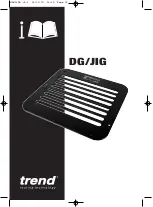
36
37
6.13 Check and clean the air filter
The air filter must be checked
and, if necessary, be cleaned be-
fore every commissioning opera-
tion in order to prevent damage
or an engine defect. If the air
filter is dirty, this obstructs the
air flow to the carburetor which
in turn reduces engine power.
Follow these instructions when checking and cleaning the
air filter.
1. Shut down the machine
(see Chapter 6.8.2 “Switching
off machine in a normal case” on page 31)
and let it cool
down.
2. Position the machine so that the engine is in a horizon-
tal position and secure the machine to prevent it from
toppling over.
3. Unfasten the lock nut
on the air filter cover
(see
Figure 36: Unscrewing and removing the lock nut)
.
4. Pull off and remove the air filter cover
(see Figure 38:
Removing the air filter cover)
.
5. Pull off and remove the foam filter element
(see
Figure 38: Removing the foam filter element)
.
6. If necessary, wipe dirt off air filter housing and cover with
a damp cloth. Ensure while doing so that no dirt enters
the carburetor.
7. Clean the paper filter insert.
–
Knock out the filter insert several times on a hard
surface to remove the dust, or
–
blow out the filter insert with compressed air
(not more than 207 kPa/2.1 kgf/cm).
–
Never try to remove the dirt with a brush because
this would cause the dirt to penetrate the fibres.
8. Cleaning the foam filter insert:
a Clean with warm soapy water, rinse and then dry
thoroughly, or clean in a non-flammable solvent
and leave it to dry.
b Dip the filter insert in clean engine oil and squeeze
out the surplus oil.
–
If too much oil is left in the foam, the engine
will smoke when it is being started.
c
Replace the foam filter element with a new one if
soiling is excessive or if it is damaged.
9. Reassemble the air filter in reverse order.
Figure 36:
Unscrewing and removing the lock nut
Figure 37:
Removing the air filter cover
Figure 38:
Removing the foam filter element
7 Troubleshooting
This chapter lists some typical problems which may occur
during operation.
If maintenance is required to
remove a problem, this must only
be carried out by qualified main-
tenance personnel.
All maintenance work on the
engine is described in the engine
manufacturer’s instructions.
Problem
Possible causes
Removal
Engine will not
start.
Fuel tap is in the OFF position.
Move the lever into the ON position.
The choke lever is in the OPEN position.
Move the lever into the CLOSED position.
The engine switch is in the OFF position.
Move the engine switch into the ON position.
The engine oil level is too low.
Fill up recommended oil to the correct oil level
(see Chap-
ter 6.12.2 “Check and fill in engine oil” on page 34)
.
The engine fuel tank is empty.
Fill up with fuel
(see Chapter 6.12.1 “Check and fill in fuel”
on page 33)
.
The fuel in the engine tank is of inferior
quality.
Drain the tank and the carburetor. Fill up with clean fuel
(see Chapter 6.12.1 “Check and fill in fuel” on page 33)
.
The spark plug is defective, dirty or its
electrode spacing is incorrect.
Correct the electrode spacing or replace the plug.
The spark plug is wet.
Remove, dry then reinstall the spark plug. Start the engine
with the throttle lever in MAX position.
The fuel filter is clogged.
The carburetor is defective.
The ignition system is defective.
The valves are jammed etc.
Replace or repair defective components as required.
Engine misfires
then cuts out.
The spark plug is wet.
Remove, dry then reinstall the spark plug.
Start the engine with the throttle lever in MAX position.
The engine loses
power.
The filter insert(s) is/are dirty or clogged.
Clean or replace the filter insert(s).
The fuel in the engine tank is of inferior
quality.
Drain the tank and the carburetor. Fill up with clean petrol
(see Chapter 6.12.1 “Check and fill in fuel” on page 33
).
The fuel filter is clogged.
The carburetor is defective.
The ignition system is defective.
The valves are jammed. etc.
Replace or repair defective components as required.
EN
GLISH
DEUT
SC
H
TORQUE WRENCH WT 1400 P
OPERATING MANUAL
NOTE
NOTE
















































